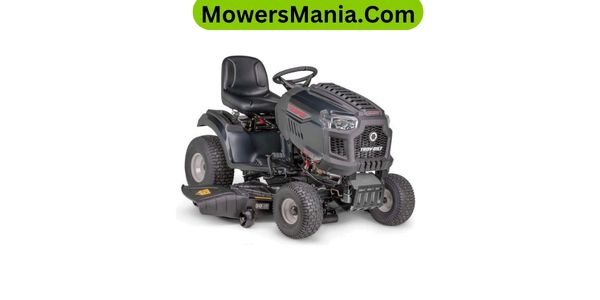Did you know that regular maintenance can extend the lifespan of your Troy-Bilt riding mower by up to 50%? Keeping your mower in top condition doesn’t have to be a daunting task.
By following a few simple maintenance tips, you can ensure that your Troy-Bilt riding mower continues to perform at its best for years to come.

From changing the oil to inspecting and replacing spark plugs, there are several key maintenance tasks that can make a significant difference in the performance and longevity of your mower.
Stick around to discover these essential maintenance tips that will keep your Troy-Bilt riding mower running smoothly and efficiently.
Oil Change and Filter Replacement
To maintain your Troy-Bilt riding mower, it’s crucial to regularly change the oil and replace the filter. This is essential for keeping your mower running smoothly and efficiently.
Start by running the engine for a few minutes to warm up the oil, making it easier to drain. Then, turn off the engine, remove the oil drain plug, and allow the old oil to drain into a suitable container. Once the oil has fully drained, replace the drain plug and refill the engine with the recommended oil, taking care not to overfill.
Next, it’s time to replace the oil filter. Using an oil filter wrench, carefully remove the old filter, taking care to minimize oil spills.
Before installing the new filter, lubricate the gasket with a small amount of fresh oil to ensure a proper seal. Then, screw the new filter into place, being careful not to overtighten it.
Once everything is securely in place, start the engine and check for any leaks. Regularly changing the oil and filter will help extend the life of your Troy-Bilt riding mower and keep it performing at its best.
Spark Plug Inspection and Replacement
When it comes to maintaining your Troy-Bilt riding mower, checking the spark plug should be a regular part of your routine. Look for signs of wear, such as carbon buildup or a worn electrode, as these can affect the mower’s performance.
If you notice any issues, it’s important to replace the spark plug to keep your mower running smoothly.
Checking Spark Plug
Inspecting and replacing the spark plug on your Troy-Bilt riding mower is essential for maintaining optimal engine performance.
To check the spark plug, follow these steps:
- Disconnect the spark plug wire and remove the spark plug with a spark plug wrench.
- Inspect the spark plug for any signs of damage, such as cracks or carbon deposits.
- Measure the spark plug gap using a feeler gauge and adjust it to the manufacturer’s specifications if necessary.
- If the spark plug shows significant wear or damage, it’s time to replace it with a new one.
| Spark Plug Condition | Action |
|---|---|
| No damage, proper gap | Reinstall |
| Minor damage, proper gap | Clean or replace |
| Significant damage, improper gap | Replace |
Regularly checking and maintaining the spark plug will ensure smooth engine operation and efficient performance.
Signs of Wear
A worn spark plug can lead to inefficient engine performance and should be inspected and replaced as needed to maintain optimal mower operation.
To check for signs of wear, start by inspecting the spark plug for any black carbon deposits, which indicate a rich fuel mixture, or white deposits, which indicate a lean fuel mixture.
Additionally, look for any signs of physical damage such as cracks or erosion on the electrodes. If you notice any of these signs, it’s time to replace the spark plug.
When replacing the spark plug, ensure that it’s tightened to the manufacturer’s specifications to prevent any issues.
Replacing the Plug
To ensure optimal performance for your Troy-Bilt riding mower, regularly inspect and replace worn spark plugs. Spark plugs that are worn can lead to inefficient engine operation if left unchecked.
When replacing the spark plug, it is important to ensure that the engine is cool. Removing the spark plug wire and using a spark plug wrench, carefully loosen and remove the old spark plug.
While inspecting the old spark plug, check the electrode for wear and the gap for any abnormalities. If necessary, replace the old spark plug with a new one of the same heat range.
To install the new spark plug, tighten it by hand and then give it a quarter turn using the spark plug wrench. After the new spark plug is securely in place, reattach the spark plug wire.
Air Filter Maintenance
Ensure that the air filter is clean and free of debris to maintain optimal performance of your Troy-Bilt riding mower. A clogged air filter can restrict airflow to the engine, leading to reduced power and efficiency.
To keep your mower running smoothly, regularly inspect the air filter for dirt, grass clippings, and other debris. Depending on usage, it’s recommended to check the air filter every 25 hours of operation and replace it annually, or more frequently in dusty conditions.
To inspect the air filter, locate the filter cover near the engine and remove it. Take out the air filter and hold it up to the light. If you can’t see light through the filter, it’s time for a clean or a replacement.
If the air filter is dirty, gently tap it on a flat surface to dislodge debris or use compressed air to blow out any trapped dirt. If the filter is damaged or excessively dirty, it’s best to replace it with a new one.
Keeping the air filter clean and well-maintained is essential for the longevity and performance of your Troy-Bilt riding mower.
Mower Deck Cleaning and Inspection

Regularly cleaning and inspecting the mower deck is crucial for maintaining the performance and longevity of your Troy-Bilt riding mower.
Here are some essential steps to properly clean and inspect your mower deck:
- Remove Debris: Before cleaning, make sure to remove any accumulated grass clippings, dirt, and debris from the mower deck. Use a brush or a putty knife to scrape off stubborn build-up.
- Check for Damage: Inspect the mower deck for any signs of damage such as cracks, dents, or rust. Pay particular attention to the blades, spindle assemblies, and belt for wear and tear.
- Lubrication: Ensure that all moving parts, such as pulleys and spindle assemblies, are properly lubricated to prevent friction and wear. Use a suitable lubricant recommended by Troy-Bilt.
Regularly cleaning and inspecting your mower deck won’t only help in maintaining the cutting performance but also extend the life of your riding mower.
By following these simple maintenance practices, you can ensure that your Troy-Bilt riding mower continues to operate at its best for years to come.
Tire Pressure Check and Adjustment
It’s important to regularly check the tire pressure on your riding mower to ensure it’s at the recommended level.
Additionally, keeping an eye on the tire treads will help you identify any signs of wear or damage.
If necessary, adjusting the tire pressure can help maintain optimal performance and stability while mowing.
Proper Tire Inflation
One important aspect of maintaining your Troy-Bilt riding mower is to regularly check and adjust the tire pressure to ensure optimal performance and longevity. Proper tire inflation is crucial for a smooth and efficient mowing experience.
Here’s how to do it:
- Check the Pressure:
- Use a tire pressure gauge to check the current pressure in each tire.
- Compare the reading to the recommended PSI (pounds per square inch) in the owner’s manual.
- Adjust as Needed:
- Add or release air to the tires as necessary to reach the recommended PSI.
- Ensure all tires are inflated evenly to maintain balance and stability while mowing.
- Regular Maintenance:
- Make it a habit to check the tire pressure before each mowing session to keep your Troy-Bilt riding mower in top condition.
Checking Tire Treads
To ensure optimal performance and safety, regularly inspect the tire treads on your Troy-Bilt riding mower and replace them if they’re worn beyond the recommended depth.
Start by checking the tire pressure with a gauge and adjust it to the recommended PSI as specified in your mower’s manual. Proper tire pressure ensures even tread wear and better traction.
Next, visually inspect the tire treads for signs of wear, such as uneven patterns, bald spots, or worn-out areas. If the tread depth is shallower than 2/32 of an inch, it’s time to replace the tires to maintain traction and stability.
Remember to check the tire treads regularly, especially before each mowing season, to keep your Troy-Bilt riding mower in top condition.
Adjusting Tire Pressure
Regularly checking and adjusting the tire pressure of your Troy-Bilt riding mower is essential for maintaining optimal performance and safety.
Here’s how to do it:
- Check the current pressure:
- Use a tire pressure gauge to measure the pressure in each tire.
- Ensure the pressure matches the recommended PSI in the owner’s manual.
- Adjust the pressure if needed:
- Add air using a compressor if the pressure is too low.
- Release air using a pressure gauge if the pressure is too high.
- Monitor regularly:
- Check the tire pressure at the beginning of each mowing season and periodically throughout the year to ensure consistency.
Proper tire pressure ensures better traction, maneuverability, and overall performance of your riding mower.
Blade Sharpening and Balancing

Sharpen and balance the blades of your Troy-Bilt riding mower regularly to ensure optimal cutting performance and safety.
Dull blades tear the grass, leaving ragged edges that invite diseases and pests. Properly sharpened and balanced blades give a clean, even cut, promoting a healthier lawn.
Here’s a simple guide to help you sharpen and balance your mower blades:
| Tools Needed | Materials Needed | Steps |
|---|---|---|
| Bench grinder | Safety gloves | 1. Disconnect the spark plug. |
| Blade balancer cone | Eye protection | 2. Remove the blade. |
| Socket wrench | Rags | 3. Sharpen the blade with the grinder. |
| Blade sharpener file | 4. Check blade balance. | |
| 5. Reinstall the blade. |
Regular maintenance of your mower’s blades will not only ensure a well-manicured lawn but also extend the life of your mower. So, set aside some time for this essential task to keep your Troy-Bilt riding mower in top condition.
Frequently Asked Questions [FAQs]
Is There a Recommended Schedule for Overall Maintenance of a Troy-Bilt Riding Mower?
You should follow the recommended maintenance schedule for your Troy-Bilt riding mower, including regular oil changes, air filter cleaning, and blade sharpening. This will keep your mower running smoothly and help prevent costly repairs.
What Are Some Common Signs That Indicate It’s Time to Replace the Belts on a Troy-Bilt Riding Mower?
When it’s time to replace the belts on your Troy-Bilt riding mower, look for signs like visible wear, cracking, or slipping. Also, if the mower struggles to move or the blades don’t engage properly, it’s likely time for new belts.
How Do I Properly Store My Troy-Bilt Riding Mower During the Off-Season to Ensure It Stays in Good Condition?
To properly store your Troy-Bilt riding mower during the off-season, clean it thoroughly, change the oil, and remove the battery. Store it in a dry, covered area to protect it from the elements and ensure it stays in good condition.
Are There Any Specific Troubleshooting Tips for Addressing Issues With Steering or Maneuverability on a Troy-Bilt Riding Mower?
If you’re experiencing steering or maneuverability issues with your Troy-Bilt riding mower, start by checking the tire pressure, inspecting the steering components for damage, and ensuring the steering gear is properly lubricated. Adjustments or replacements may be necessary.
What Are Some Best Practices for Maintaining the Battery on a Troy-Bilt Riding Mower to Prolong Its Lifespan?
To maintain the battery on your Troy-Bilt riding mower, regularly check the connections for corrosion, clean them if needed, and ensure the battery is securely mounted. Keep it charged during off-seasons to prolong its lifespan.
Conclusion
Now that you have learned these maintenance tips for your Troy-Bilt riding mower, you can keep it running smoothly for years to come.
By regularly changing the oil and filter, inspecting and replacing the spark plug, maintaining the air filter, cleaning the mower deck, checking tire pressure, and sharpening and balancing the blades, you can ensure your mower stays in top condition.
With these simple steps, you’ll be able to enjoy a well-maintained and reliable mower for all your landscaping needs.



